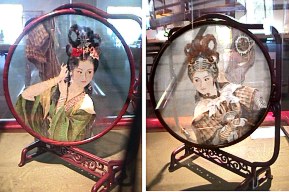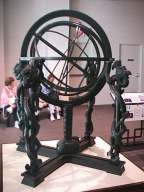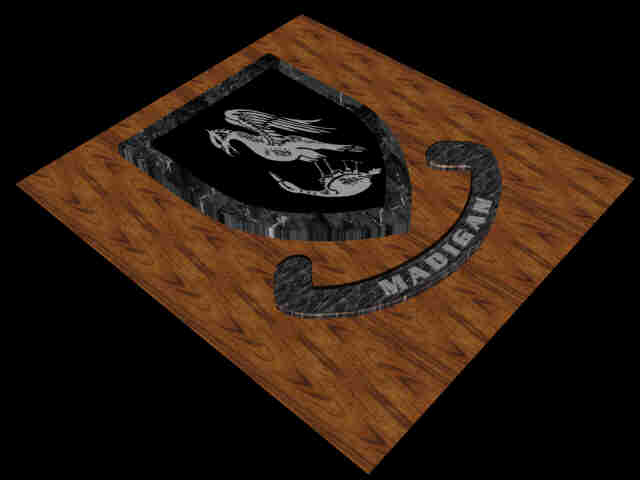One particular piece was
most fascinating. The face of a young girl, done in the  finest
of stitches was suspended in a frame behind glass so that I could
walk around and see both sides. The shape of the girl's head was
the same of course, but the actual faces were different. So fine
was the workmanship that at the distance of a foot or so, the
stitches were all but invisible leaving the impression of a
painting yet oddly translucent. I decided to find a knot or
string or something in it, and began a systematic search inch by
inch. Within
finest
of stitches was suspended in a frame behind glass so that I could
walk around and see both sides. The shape of the girl's head was
the same of course, but the actual faces were different. So fine
was the workmanship that at the distance of a foot or so, the
stitches were all but invisible leaving the impression of a
painting yet oddly translucent. I decided to find a knot or
string or something in it, and began a systematic search inch by
inch. Within 15 minutes I gave up with nothing found. Such a
piece of work takes years to complete and can cost the artisan
her eyes from the concentration. My love of the sea was
re-kindled as I found models of ancient instruments of navigation
and old ships in another section of the museum. The Armilla
sphere appeared in China in the second century BC and was used to
measure the positions of astronomical objects. It is based on the
"torquetum" developed by the Arabs. The original was
cast in bronze and erected in Shanxi Province. The equatorial
mounting on a later date simplified armilla has four coordinates,
centigrade markings and an equatorial circle, and is similar to
the basic structure of the equatorial mounting of the modern
telescope. Not far from there was a delightful
15 minutes I gave up with nothing found. Such a
piece of work takes years to complete and can cost the artisan
her eyes from the concentration. My love of the sea was
re-kindled as I found models of ancient instruments of navigation
and old ships in another section of the museum. The Armilla
sphere appeared in China in the second century BC and was used to
measure the positions of astronomical objects. It is based on the
"torquetum" developed by the Arabs. The original was
cast in bronze and erected in Shanxi Province. The equatorial
mounting on a later date simplified armilla has four coordinates,
centigrade markings and an equatorial circle, and is similar to
the basic structure of the equatorial mounting of the modern
telescope. Not far from there was a delightful  model
of a 180 ton merchant ship pulled up off the bottom of Quanzhou
Bay, Fujian Province in 1973. It sank in the 13th century AD at a
time when Chinese ships made long-distance voyages between China,
Southeast Asia and India. The model was constructed using details
found during the excavation. As I wandered around I found all
kinds of other things that are credited to Chinese inventiveness.
The first odometer was fascinating. It was invented by an
engineer named Ma Jun. It was a horse drawn cart with a drum
mounted
model
of a 180 ton merchant ship pulled up off the bottom of Quanzhou
Bay, Fujian Province in 1973. It sank in the 13th century AD at a
time when Chinese ships made long-distance voyages between China,
Southeast Asia and India. The model was constructed using details
found during the excavation. As I wandered around I found all
kinds of other things that are credited to Chinese inventiveness.
The first odometer was fascinating. It was invented by an
engineer named Ma Jun. It was a horse drawn cart with a drum
mounted  on it. A wooden figure stood with mallet in hand
ready to strike the drum. His arm was activated by a set of
reduction gears driven by the axle. He beat the drum every
"li" or about 500 yards. It was not all serious study.
There were a myriad of things for kids to do. A set of cast iron
bells carrying perfect pitch were on display along with a mallet
for striking. And then, there was a most curious cast iron bowl
containing water. Laura went up to it and following the
children's instruction, wet her hands and then vigorously began
rubbing them back and forth on the side handles. Suddenly a tiny
array of bubbles formed
on it. A wooden figure stood with mallet in hand
ready to strike the drum. His arm was activated by a set of
reduction gears driven by the axle. He beat the drum every
"li" or about 500 yards. It was not all serious study.
There were a myriad of things for kids to do. A set of cast iron
bells carrying perfect pitch were on display along with a mallet
for striking. And then, there was a most curious cast iron bowl
containing water. Laura went up to it and following the
children's instruction, wet her hands and then vigorously began
rubbing them back and forth on the side handles. Suddenly a tiny
array of bubbles formed  along the edge of the water, and as they rose
and broke, an eerie high pitched hum was emitted. It was most
peculiar. There were some dozen artisans working at various
projects all along the back wall of the museum. some were
painting, some were demonstrating the paper making machines, and
one was carving a Chinese stone, similar to soapstone. For a few
dollars he would carve the Chinese symbols for your name into the
base of a pre-cut stone and make a stamp out of it. All in all it
was quite a full day, and one that was very much enjoyed. The
exhibit is on tour throughout the US for the remainder of the
year before returning to China. Should it pass your way, it is
definitely worth the trip.
along the edge of the water, and as they rose
and broke, an eerie high pitched hum was emitted. It was most
peculiar. There were some dozen artisans working at various
projects all along the back wall of the museum. some were
painting, some were demonstrating the paper making machines, and
one was carving a Chinese stone, similar to soapstone. For a few
dollars he would carve the Chinese symbols for your name into the
base of a pre-cut stone and make a stamp out of it. All in all it
was quite a full day, and one that was very much enjoyed. The
exhibit is on tour throughout the US for the remainder of the
year before returning to China. Should it pass your way, it is
definitely worth the trip.

